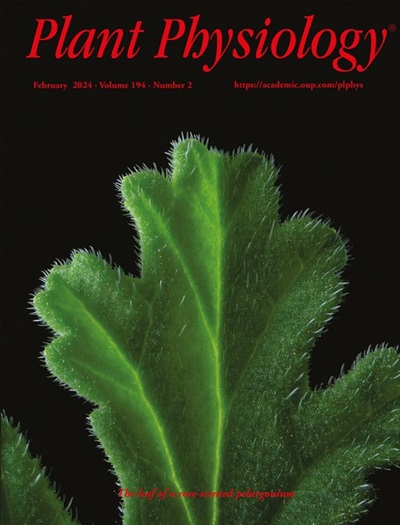通过配子体转化对模式蕨类植物进行高效基因编辑
IF 6.5
1区 生物学
Q1 PLANT SCIENCES
引用次数: 0
摘要
簇状规则间隔短回文重复序列(CRISPR)/CRISPR相关核酸酶(Cas)系统可以对许多植物物种的基因进行精确而简便的编辑。然而,由于蕨类植物基因组、遗传学和生理学的复杂特性,该系统尚未通过配子体应用于任何蕨类植物物种。在这里,我们建立了一个基于配子体的单导RNA(sgRNA)筛选方案,该方案能高效地在模式蕨类植物 Ceratopteris richardii 中进行 CRISPR/Cas9 介导的基因敲除。在这一 CRISPR 介导的编辑系统中,我们利用 C. richardii ACTIN 启动子驱动 sgRNA 的表达,并利用增强型 CaMV 35S 启动子驱动化脓性链球菌 Cas9 的表达,成功编辑了几个基因,如核苷酸酶/磷酸酶 1(CrSAL1)和植物烯去饱和酶(CrPDS),从而导致 C. richardii 出现白化表型。敲除 CrSAL1 会显著降低(P<0.05)气孔导度(gs)、叶片蒸腾速率(E)、保卫细胞长度以及脱落酸(ABA)诱导的保卫细胞活性氧(ROS)积累。此外,与野生型(WT)植株相比,CrSAL1过表达植株的净光合速率(A)、gs和E以及大多数气孔性状和ABA诱导的ROS在保卫细胞中的产生均显著增加。总之,我们优化的 CRISPR/Cas9 系统为模式蕨类植物的功能基因组学提供了有用的工具,使人们能够探索蕨类植物基因的功能,从而促进进化生物学、中草药发现和农业应用。本文章由计算机程序翻译,如有差异,请以英文原文为准。
Efficient gene editing of a model fern species through gametophyte-based transformation
The clustered regularly interspaced short palindromic repeats (CRISPR)/CRISPR-associated nuclease (Cas) system allows precise and easy editing of genes in many plant species. However, this system has not yet been applied to any fern species through gametophytes due to the complex characteristics of fern genomes, genetics, and physiology. Here, we established a protocol for gametophyte-based screening of single-guide RNAs (sgRNAs) with high efficiency for CRISPR/Cas9-mediated gene knockout in a model fern species, Ceratopteris richardii. We utilized the C. richardii ACTIN promoter to drive sgRNA expression and the enhanced CaMV 35S promoter to drive the expression of Streptococcus pyogenes Cas9 in this CRISPR-mediated editing system, which was employed to successfully edit a few genes, such as Nucleotidase/phosphatase 1 (CrSAL1) and Phytoene Desaturase (CrPDS), which resulted in an albino phenotype in C. richardii. Knockout of CrSAL1 resulted in significantly (P<0.05) reduced stomatal conductance (gs), leaf transpiration rate (E), guard cell length, and abscisic acid (ABA)-induced reactive oxygen species (ROS) accumulation in guard cells. Moreover, CrSAL1 overexpressing plants showed significantly increased net photosynthetic rate (A), gs, and E as well as most of the stomatal traits and ABA-induced ROS production in guard cells compared to the wild-type (WT) plants. Taken together, our optimized CRISPR/Cas9 system provides a useful tool for functional genomics in a model fern species, allowing the exploration of fern gene functions for evolutionary biology, herbal medicine discovery, and agricultural applications.
求助全文
通过发布文献求助,成功后即可免费获取论文全文。
去求助
来源期刊

Plant Physiology
生物-植物科学
CiteScore
12.20
自引率
5.40%
发文量
535
审稿时长
2.3 months
期刊介绍:
Plant Physiology® is a distinguished and highly respected journal with a rich history dating back to its establishment in 1926. It stands as a leading international publication in the field of plant biology, covering a comprehensive range of topics from the molecular and structural aspects of plant life to systems biology and ecophysiology. Recognized as the most highly cited journal in plant sciences, Plant Physiology® is a testament to its commitment to excellence and the dissemination of groundbreaking research.
As the official publication of the American Society of Plant Biologists, Plant Physiology® upholds rigorous peer-review standards, ensuring that the scientific community receives the highest quality research. The journal releases 12 issues annually, providing a steady stream of new findings and insights to its readership.
 求助内容:
求助内容: 应助结果提醒方式:
应助结果提醒方式:


